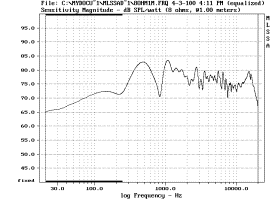
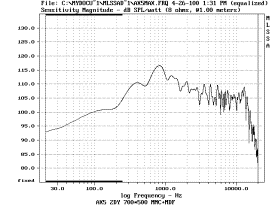
New testing to re-confirm maximum power measurement.
A new material is included in this test. It is used to test maximum power handling and the inverse Sq law phenomenon of DML.
Panel
Material
: sensored
Measurement System
: MLSSA
Panel
Thickness
: sensored
Mic to Source Distance
: 1 meter
Panel
Size
: sensored
Acquisition Length
: 65535
Panel
Surface Finishing : sensored
Antialiasing Filter
: Chebyshev
Panel
Stuck down by
: sensored
Bandwidth
: 20kHz
Exciters
No. & Type
: sensored
FFT Window
: Rectangular
Exciters
Holder
: sensored
FFT Size
: 65535
Exciters
Position 1
: sensored
Best Resolution
: 0.92Hz
Exciters
Position 2
: sensored
FFT Mode
: Sensitivity 8W
- 1m
Wires
Stuck down by :
sensored
FFT start to end time
: 2.88ms to 6.88ms
Type
of Frame
: sensored
Hanging or on Floor
: Hanging
MLSSA stimulus is set at –3dB. Amplifier volume is set at a minimum of –42dB. Max volume is 0dB. A MLSSA Transfer Function of the Frequency Response from MLSSA output to Amplifier’s input through Speaker output back into MLSSA input was taken. The file is saved and used as reference to offset for both frequency response & sensitivity type measurement.
FFT mode is sensitivity at 8W 1m. When amplifier’s volume is unchanged at –42dB, the sensitivity of the panel is 84dB 1w/1m @1kHz. This is absolutely correct hence the calibration is correct for this power test.
sensored panel have sensored Polyswitch. sensored does not.
The internal Polyswitch is used as reference to set maximum power handling, where the amplifiers volume is increased till the Polyswitch kicks in. The volume is turned down for the Polyswitch to recover and a slightly reduce volume is used. The process is repeated until the Polyswitch does not kick in at all and sustain for at least 30minutes. The test tone is MLSSA stimulus.
The Amplifier volume is then increased. Since MLSSA does not know this, it simply measures the impulse response as it is, (at higher volume). The FFT operation is then performed as normal but in fact is louder.
During MLSSA FFT operation if standard conversion method is used then it should give a correct representation of the measured SPL. If extra formula is involved during FFT then this method of measurement for maximum power handling in not appropriate.
By normal the sensored panel should reach sensored dB SPL at sensored RMS from sensored at 1w/1m @ 1kHz. But please see the graph at the rear where it shows sensored dB SPL, which is very close to the previous report of sensored dB SPL. What is surprising is that at sensored dB it is consuming nearly sensored watts.
The previous reports state this panel have a sensitivity of sensored dB but it was read wrongly on the graph and is in fact sensored dB, like this one.
The sensored panel material started at sensored dB SPL 1w/1m @ 1kHz, therefore it should reach sensored dB SPL at 20watts RMS. But graph at the rear shows sensored dB SPL, which is nearly sensored watts.
Again The NXT® quote of high mechanical to acoustical transfer of sensored % is responsible.
This is sensored sensored at 1w/1m sensored dB vs. maxpower/1m sensored dB


The is sensored 1w/1m sensored dB vs. maxpower/1m sensored dB
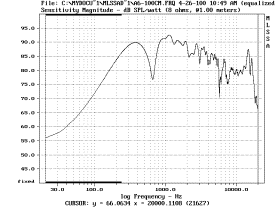
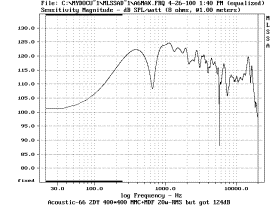
The DML is said not to have the conventional piston speaker inverse square law properties, where SPL level drops by 6dB per doubling of distance. 3 measurements were made at distance of 0.5m, 1m & 2m. The result shows an exact inverse square law fall of 6dB per doubling of distance. The measured result is anechoic simulated.
The Setup of distance measurement is as easy as on top. It is the usual sensitivity measurement. The only change is the distance from the source to the microphone. Since MLSSA was not informed of the changes it will measure the SPL as it is and report it. For this case it has proven correct. This also leads to think the increase of amplifier volume to simulate a maximum power-handling test on top is also correct.
A cross check was carried out to confirm the measurement. Where the 0.5meters impulse response was put through FFT MODE Sensitivity 8W 0.5m and it gave 92dB. And the one for 2m, FFT MODE Sensitivity 8W 2m and it also gave 92dB.
There is variance sometimes of 0.5dB that is due to the small difference during windowing due to human error.
The frequency response is all different for the 3 different distances, which is also stated in the MLSSA manual. The manual state 1m distance should be used for frequency response measurement, or else only the sensitivity level is correct.
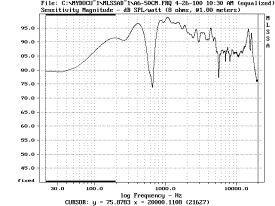
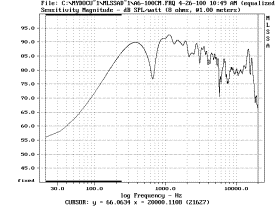
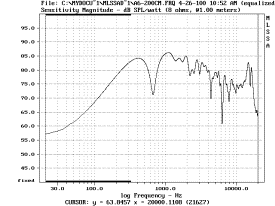
Graph to prove MLSSA sensitivity feature working fine and can be fooled under control.
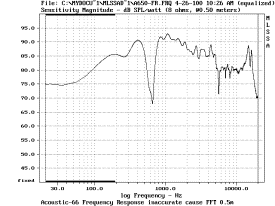
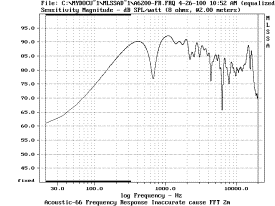
A DML can always produce higher SPL than expected by over a few hundred percent or may be into the thousand percent of the stated wattage power handling. Why is it so is unknown at the moment. There are also doubts whether the measuring technique is correct or not.
A DML still obeys the Inverse Square Law 100% and not as stated otherwise.
Measurement method used for checking Inverse Square Law is correct and is strongly related to maximum power handling test, hence both technique it correct. MLSSA is fooled successfully.
ACOUSTICS SECTION AUDIO SECTION CAR SECTION
HOME - Technical Website for Acoustics, Audio and Car